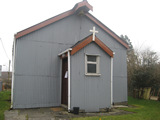 In
1925 the Reverend William Herbert Jones, vicar at St Mary’s Church,
Seven Sisters decided to build a branch Church at Duffryn Cellwen. The
church, a corrugated iron building, was officially opened in October 1925
and named St David’s Church. Each year on St David’s Day the
church plays host to the Daffodil Festival.
In
1925 the Reverend William Herbert Jones, vicar at St Mary’s Church,
Seven Sisters decided to build a branch Church at Duffryn Cellwen. The
church, a corrugated iron building, was officially opened in October 1925
and named St David’s Church. Each year on St David’s Day the
church plays host to the Daffodil Festival.
 The Neath and Dulais valleys were used as communication routes by the
Romans and the fort and camp were part of a network of military sites across
south Wales. The temporary marching camp may date from the campaigns against
the Silures around 74-78 AD. The fort, known as the Gaer, was probably
built during the same period, as a more permanent base. It would have held
over 400 troops and was in use for about 500 years, until the troops were
sent north to Hadrian’s Wall.
The Neath and Dulais valleys were used as communication routes by the
Romans and the fort and camp were part of a network of military sites across
south Wales. The temporary marching camp may date from the campaigns against
the Silures around 74-78 AD. The fort, known as the Gaer, was probably
built during the same period, as a more permanent base. It would have held
over 400 troops and was in use for about 500 years, until the troops were
sent north to Hadrian’s Wall.
Please click the red symbols on the map for more information. You can also click the small images on the pop-ups to see larger versions.

![]()
Iron making and coal mining created this settlement soon after the Onllwyn enterprises. Banwen colliery opened in 1845 together with the erection of the colliery houses. A later development was the opening of the larger Maesmarchog mine and more workers housing. Banwen ironworks was established in 1847 but only lasted until 1854. This area was very isolated before the Neath and Brecon Railway opened in 1863. Until then the only means of conveying the coal and iron out of the valley from Onllwyn and Banwen was by a horse-drawn tramroad westwards to the Swansea Canal near Ystradgynlais.
Banwen - Surrounded by myth and legend
Please click the picture to below to open a slideshow of larger pictures from the Banwen Village Trail.
